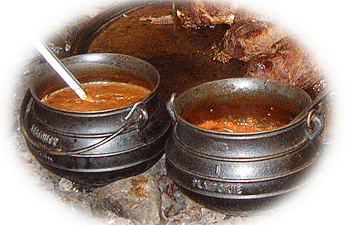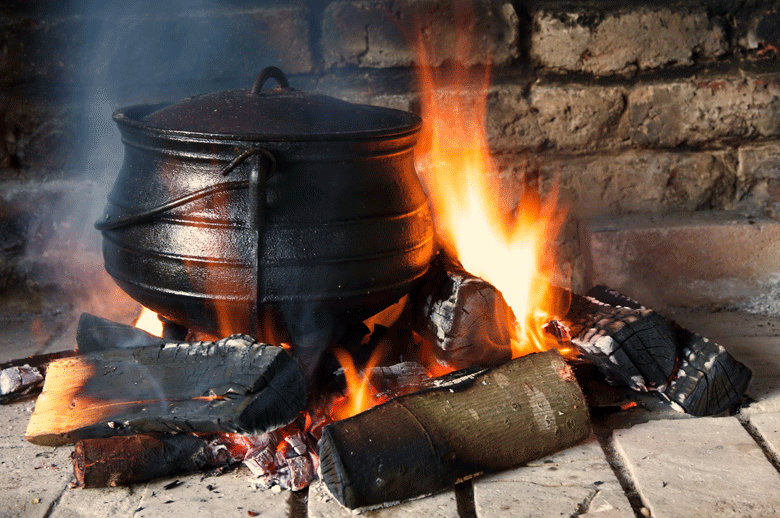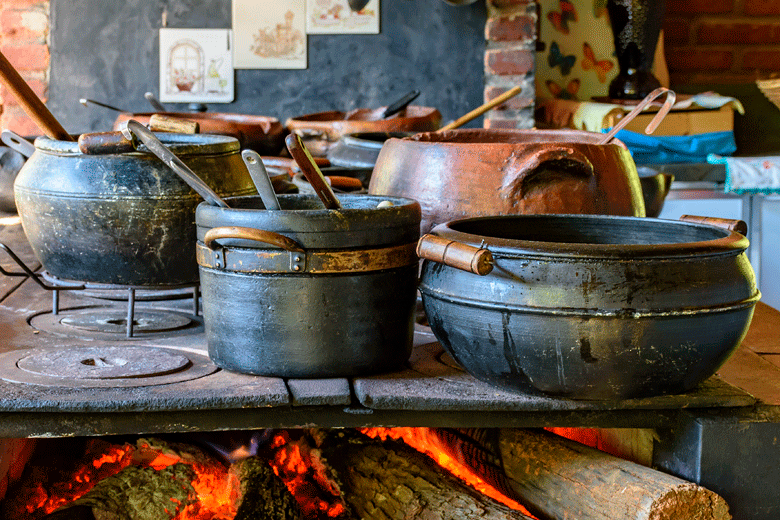When did it start?
Slow cooking dates back to the start of organised society. People living in towns would cook their bread in a shared central wood burning oven situated in the town centre. At the end of the day once all the bread had been cooked, the oven would still be really hot. While it was cooling down, the townsfolk would place their cooking pots into the oven. They would allow their food to cook slowly overnight. The next day, the food would be fully cooked, tender, and full of flavour.
The slow cooking used by the Greeks to make Kleftiko has a similar history. The story goes that when thieves stole a lamb, they would dig a hole and build a fire with lots of wooden logs. Once the logs had burned down, they would place the lamb on top of the smouldering embers, cover the hole with soil and seal it with mud. They did as a way of preventing the smell of their cooking, leading pursuers to where they were. Once the threat of capture had diminished, they would return to remove the lamb, which now had become succulently cooked and tender from the underground oven.
The Taino and escaped slaves (Maroons) in the Caribbean used the same method of cooking to prevent being captured. They would bury wild hogs they had caught in underground ovens. Before so they would cover the hog with salt, wild herbs and spices like pimento and Chillies and then wrap them in leaves. Doing this added great spicy flavour to the meat while it cooked and keep humidity constant while the meat was cooking. This style of cooking led to what has become known today as jerking meat (as for example in Jerk Chicken and Jerk pork)
How does it work?

Collagen
The principle behind this type of cooking is that it slowly breaks down collagen in meat. Collagen is a type of protein found in cuts of meat on the bone. Its purpose when the animal is still alive is to lubricate muscles or join muscles together. It is always found in cuts where bone is joined to muscle or muscle is joined to muscle
The tougher a meat, the more collagen it will contain. When these tough cuts of meat are slow cooked, the heat and humidity of the process slowly breaks the collagen down into gelatine. This in tun softens the meat and makes it extremely juicy, stick and savoury
extremely juicy, stick and savoury
Where Feijoada was considered the food of slaves, thanks to slow cooking it is now the national dish of Brazil. Cheap cuts of meat are cooked slowly, with sausages and beans until all the flavours mingle, and beans and meat are tender. The same principle applies in South African Potjiekos. Meat and vegetables are slowly cooked in three legged cauldron called a potjie. The dish can take all day to prepare, with a potjie being started early in the morning and only eaten for dinner in the evening. Making a potjie is a very social occasion, as people can sit around the fire enjoying a beverage or two while the food is slowly gets cooked.
When making curries, the slow cooking process not only makes the meat tender and juicy, but the spices also get the time to infuse the gravy with fantastic flavour. Mutton in particular is a meat that is used to make a wide variety of curries including Durban curry from South Africa , Lamb Vepadu and Bhuna curry from India
Slow cooked curries

Making a Bhuna
Nothing beats a curry that has been cooked long and slow. In fact, many Indian cooks will insist on using old laying hens and other tougher cuts of meat like mutton to make their curries. They do this in the knowledge that the time it takes to get these meats tender will enhance the flavour of the final product.
I used this principle when I decided to make a Bhuna. I specifically chose mutton to make this curry instead of stewing lamb. I cut the meat into bite-sized pieces and heated some ghee in the skillet. After frying some onions in the ghee until they were beginning to brown, I added garlic and fresh root ginger (peeled and finely grated). Once the aromatics were starting to get some colour, I added a red bell pepper (seeds and stalk removed) that I had cut into fine strips. I then added green Indian Chillies that I had topped and sliced in half. After the bell pepper and the chillies were started to soften, I added my spices. These were cinnamon stick, cloves, green cardamom pods, Chilli powder, coriander powder and garam masala
ginger (peeled and finely grated). Once the aromatics were starting to get some colour, I added a red bell pepper (seeds and stalk removed) that I had cut into fine strips. I then added green Indian Chillies that I had topped and sliced in half. After the bell pepper and the chillies were started to soften, I added my spices. These were cinnamon stick, cloves, green cardamom pods, Chilli powder, coriander powder and garam masala
I let the spice become fragrant, and then added the meat. I coated the meat with the onion/ masala mix and let the meat brown slowly. I used to add a bit of lamb stock to prevent the meat from catching. After the meat started browning, I added chopped tomatoes and some more lamb stock. Once everything was well combined. I took the skillet off the stove and let the curry cool a bit.
After about fifteen minutes, I transferred everything into a slow cooker and turned it onto a slow cook. The temperature on the slow cooker was 70 degrees Celsius. I cooked the curry for about ten hours without taking off the lid.
After the ten hours, the time had come for the final reckoning. I tasted it and liked what I had achieved. It was savoury, nicely spiced and unctuous. It is definitely worth making again



